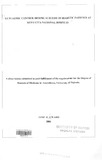| dc.contributor.author | Gwaro, Jane K | |
| dc.date.accessioned | 2013-05-25T07:23:00Z | |
| dc.date.available | 2013-05-25T07:23:00Z | |
| dc.date.issued | 2006 | |
| dc.identifier.citation | Degree of Masters of Medicine in Anaesthesia, University of Nairobi. | en |
| dc.identifier.uri | http://erepository.uonbi.ac.ke:8080/xmlui/handle/123456789/25567 | |
| dc.description | A dissertation submitted in part fulfillment of the requirement for the Degree of
Masters of Medicine in Anaesthesia, University of Nairobi. | en |
| dc.description.abstract | Objective - To study the patterns of glycaemic control in diabetic patients undergoing
surgery in Kenyatta National Hospital.
Design - A cross sectional, prospective study.
Setting - Kenyatta National Hospital operating rooms
Subjects - Diabetic patients undergoing emergency or elective surgery
Methods - Over five months, November 2005 to March 2006. Glycated haemoglobin was
determined as well as blood sugar levels pre-operatively, at half hourly or hourly
intervals intra-operatively and at reversal from anaesthesia. The vital signs of the patients
at reversal were noted.
Results - The mean HbA 1c was 4.17%, and the mean pre-operative blood sugar was 8.7
mmolll, and the mean intra-operative blood sugar was 9.14 mmolli. There was no
statistically significant correlation between HbAlc and age, sex and duration of diabetes,
but there was statistically significant correlation between HbA 1c and random blood sugar
taken at interval intra-operatively. Most of the patients managed on diet, did not receive
insulin intra-operatively. The mean total amount of insulin used intra-operatively was 6.7
units. 6.2% of patients reversed poorly from anaesthesia and their mean blood sugar was
10.1 mmolli. 14.8% of patients who reversed poorly had HbAlc > 6.4%. 4.4 % of
patients were admitted into the intensive care unit due to respiratory distress and septic
shock.
Conclusion - Pre-operative glycaemic control was optimal and patients managed on diet
had the best control and did not require insulin during surgery. Glycaemic control (mean
blood sugar < 10 mmolll) was achieved intra-operatively through use of insulin and this
was not associated with immediate post-operative complications. | en |
| dc.language.iso | en | en |
| dc.publisher | University of Nairobi | en |
| dc.title | Glycaemic control during surgery in diabetic patients at Kenyatta National Hospital | en |
| dc.type | Thesis | en |
| dc.description.department | a
Department of Psychiatry, University of Nairobi, ; bDepartment of Mental Health, School of Medicine,
Moi University, Eldoret, Kenya | |
| local.publisher | College of Health Sciences | en |

